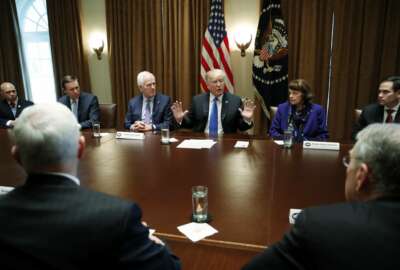
Spending on legacy IT continues to grow, but there is light at the end of the tunnel
Shawn McCarthy, the research director for IDC Government Insights, said spending on legacy systems has increased by 13 percent over the last five years alone.
Best listening experience is on Chrome, Firefox or Safari. Subscribe to Ask the CIO’s audio interviews on Apple Podcasts or PodcastOne.
After a decade of looking at federal technology spending, Shawn McCarthy doesn’t like what he sees in 2018.
McCarthy, the research director for IDC Government Insights, said spending on legacy systems has increased by 13 percent over the last five years alone. This uptick means agencies need more now than ever to relieve themselves of the burden of older IT systems.

“Legacy systems have been eating up a good chunk of the federal IT budget for most of that time,” McCarthy said on Ask the CIO. “Let’s go back 10 years, it was two-thirds legacy systems spending and one-third modernization enhancement developing spending. What we found over the years is that dropped and it’s much closer to 20 percent to 21 percent going into new systems. That means the remainder is going into legacy systems, which is one of the highest percentage I’ve ever seen.”
IDC Government Insights’ latest forecast predicted civilian agencies will spend $52 billion on technology by the time the fiscal 2018 ends.
IDC says 78.9 percent of that spending will go toward improving and maintaining legacy systems, commonly known as operations and maintenance (O&M).
McCarthy said one reason for this increase in O&M spending could be legacy systems are increasingly more expensive to maintain as finding the hardware, software and people to keep the older systems online are in shorter supply.
On the other hand, McCarthy said the reason could be credited to evolution of technology that agencies are using today.
“The spending on new systems actually may be more efficient as people have moved to cloud, as people have learned how to develop systems that have multiple purposes so less money needs to be spent on new development at this point. That may have something to do with less money going into new development. But that should also tell us a story that if it costs less to develop new and costs less to maintain for the first few years, why aren’t we moving more things off the legacy platform to newer systems? Now, obviously, that comes with its own weight. Moving an older system isn’t just about the cost of the hardware and software.”
He said moving from a legacy system often also means the need to do business process reengineering, re-architecting the way the system is built and updating code that may have been touched in decades.
McCarthy said agencies need to do more of a return on investment on the cost to continue with the current approach and the total cost to modernize. He said agencies could consider looking at their five most expensive systems and bring in an accounting firm to develop the cost-benefit analysis.
“It will be expensive, but when you look at what the legacy system is costing you 2-3-4 years down the road, we have seen most of these able to pay themselves off in a 2-to-3 year period,” he said. “It’s definitely worth having that conversation and I think the CFO needs to be a part of that conversation.”
Over the last five years, McCarthy said agencies are spending less on hardware because more and more applications are going to the cloud. At the same time, agencies also are networking equipment for a similar reason that employees need faster networks as more data and applications reside in the cloud.
“I see the spending spiking for 2019 and then leveling off again. I think the percentage of growth, which normally is at between 1-to-2 percent, will be a little bit higher,” he said. “Why? We are seeing a few things. Those people who sort of been dragging their feet and not moving to cloud are finally making that transition. We also are seeing network equipment, rip and replace of older PCs will cause a temporary spike, but not a huge difference. Also in the background, you have the data center consolidation and optimization effort. So having to merge data centers requires some upfront costs.”
Specifically, McCarthy said the Homeland Security and Veterans Affairs departments are expected to spend the most among civilian agencies on new development and modernization.
The Office of Management and Budget said civilian agencies would spend about $45.7 billion on technology in 2019, which is up about $200 million from the 2018 request.
For the first time, the White House didn’t include how much the Defense Department would spend on IT as part of its overall chapter on technology.
Based on what OMB said in other parts of the budget, however, it seems DoD will spend about $45 billion as well, which would be down from the $53.1 billion request in 2018.
Copyright © 2025 Federal News Network. All rights reserved. This website is not intended for users located within the European Economic Area.
Jason Miller is executive editor of Federal News Network and directs news coverage on the people, policy and programs of the federal government.
Follow @jmillerWFED






